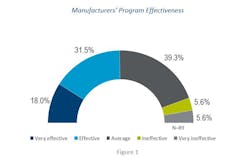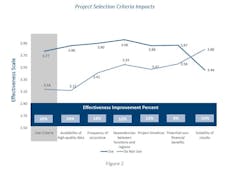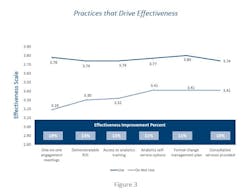Editor's Note: This article is Part 2 of a series. Read Part 1 at Setting Up Data and Analytics Teams to Drive Value.
Effectiveness is a key measure of how an organization perceives the impact of an analytics team’s efforts and how the team is engaging the business to shift toward a data-driven culture.
Overall, organizations are satisfied with their data and analytics programs. Just under half of manufacturing organizations believe that their analytics programs are either effective or very effective at creating insights to solve organizational challenges, according to a recent APQC survey. However, there is still plenty of room for programs to grow. Which leads to the question, what factors drive the perception of effectiveness by the end-users of the analytics team’s efforts and what levers do teams need to pull to improve the effectiveness of their programs?
To better understand which levers analytics teams need to focus on, we conducted a correlation analysis on data from our Trends in Data and Analytics survey.
So, what was statistically significant?
1. Resources
2. Selection Criteria
3. Engagement Drivers
Resources are Foundational
Similar to findings found in previous research on developing a data-driven culture, a key factor of success is access to the necessary data and analytics resources (including formal teams, the right skills, and access to high-quality data.)
Best-practice organizations typically use a centralized governance team combined with decentralized implementation teams—also known as a federated model—to execute the plan. However, the model structure was not as vital to perceived effectiveness as whether the staff in the teams were fulltime resources. Dedicated resources ensure two things:
1. Visibility. People know where to go to get their analysis done and build a rapport and trust with their analytics teams.
2. Quality. Analytics team members have the bandwidth to dedicate their skills to deliver the best solutions to their end-users.
Selection Criteria Provide Context
To effectively manage the influx of analytics requests, best-practice organizations use a portfolio management approach, including selection criteria to help prioritize, identify redundancies, and schedule the analytics workload. Organizations that use selection criteria are significantly more likely to find their data and analytics programs more effective.
We also found there were six criteria that directly impacted the perceptions of analytics ability to support problem-solving (figure 2).
The six criteria provide context around projects feasibility, resource needs, timing, and potential value of the project.
1. Availability of high-quality data—helps understand the scope and feasibility of the project. This includes where the data is located, if it will require work to make it usable, or if new data will need to be collected.
2. Frequency of occurrence—this helps understand the nature of the project and if it is a recurring project. Which also helps the team balance its ongoing resources and project timing.
3. Interdependencies—this helps understand the complexity of the project and look for potential overlaps or synergies to projects in other departments or regions.
4. Timelines—helps manage resource planning and turnaround time.
5. Non-financial benefits—look at the impact the project will have on less tangible benefits such as customer or employee satisfaction and turnover.
6. Volatility—this criterion captures the relative shelf-life of the analysis and how long that it is relevant.
Many of these criteria provide a positive impact on effectiveness because they help the data and analytics team appropriately scope the project by understanding the complexity and feasibility of the projects, as well as provide insights for project planning and resource allocations. This helps the team deliver their projects more effectively and clearly set expectations on the project outcomes.
Engagement Practices Drive Positive Perceptions
When asked about drivers of success, the top four drivers of effectiveness were the usual suspects: defined value, formal analytics team, success stories, and data visualization capabilities. Though these drivers are foundational to success, they aren’t enough to ensure program success.
There were six practices—again in three categories—linked to more effective programs.
1. Service Portfolio—refers to the mix of services the analytics team provides the organization. Best-practice organizations use a broad mix of solutions to support customers and stakeholders effectively.
a. Access to analytics training—provides foundational information that helps them feel more in control and provides ground rules for project expectations.
b. Self-service options—also provides a sense of control and emphasizes that data and analytics are there for the end user's convenience. Self-serve options also cater to individuals already analytics savvy and prefer to conduct the analysis on their own.
c. Consultative services—this type of service improves effectiveness because it’s a collaborative—typically iterative effort—that ensures decision-makers get the answers they need to the right questions.
2. Engagement Practices—refers to the tactics that the organization uses to build trust and set behaviors towards a specific goal.
a. Formal change management plans— ensure that the organization focuses on adoption and deliberately engages employees to change how they make decisions.
b. One-on-one engagements—provide an opportunity for the analytics team to speak directly with leaders and employees about the change.
3. Demonstrable ROI—ensures that teams are highlighting the tangible and meaningful value of analytics.
In many cases, these drivers are included in best-practice organizations formal change management plan to drive deeper engagement, which has a positive effect on the perceived effectiveness of the analytics team.
Conclusion
The study supports the idea that for your analytics program to be truly effective, organizations must have a culture that embraces data-driven decision making. And that moves beyond using analytics for more than monthly or quarterly reporting, but actively applies analytics to support decision-making for an organization’s goals and initiatives.
However, establishing a data-driven culture is an ongoing struggle and implementing an enterprise-level cultural change and making it stick is never an easy task. However, if organizations adopt some of the practices and techniques—in resources, selection criteria, and engagement practices—they can shift the perceptions of their efforts and reinforce that data-thinking culture.
Holly Lyke-Ho-Gland is process and performance principal research lead with APQC, a member-based nonprofit and one of the leading proponents of benchmarking and best practice business research.







